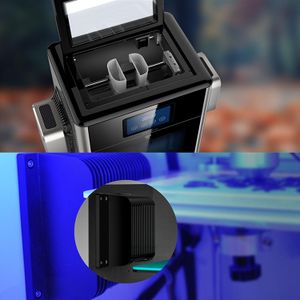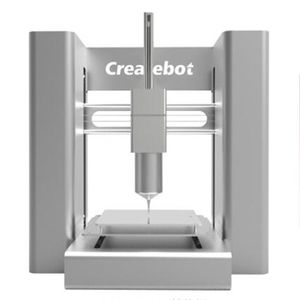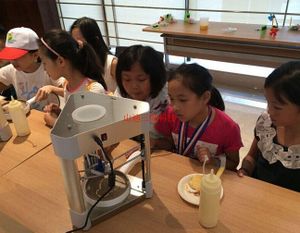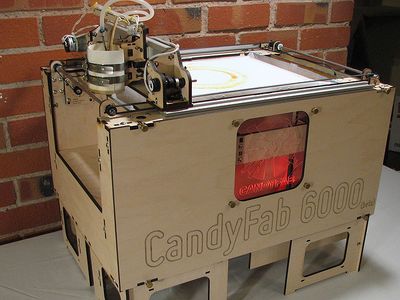3D food printing
 From EduTechWiki - Reading time: 13 min
From EduTechWiki - Reading time: 13 min
Introduction[edit | edit source]
3D food printers can print food, usually through one more syringes. Food 3D printers actually were invented around the same time as low cost filament printers, but did not have much success. The first known open source printers capable of printing food were probably developed at Cornell University around 2005 under the name of fablab@home by Hod Lipson [1] and collaborators.
As of 2017 however, there is renewed interest. 3D food printing can serve two purposes according to 3D Food Printing: It can be healthy and good for the environment because it can help to convert alternative ingredients such as proteins from algae, beet leaves, or insects into tasty products. It also opens the door to food customization and therefore tune up with individual needs and preferences.
According to Sun et al (2015),[2] identify the needs for "pretty food" and "personalized food: “Three-dimensional (3D) Food Printing, also known as Food Layered Manufacture (Wegrzyn et al. 2012), can be one of the potential ways to bridge this gap. It is a digitally controlled, robotic construction process which can build up complex 3D food products layer by layer (Huang et al. 2013). It has started a revolution in cooking by precisely mixing, depositing, and cooking layers of ingredients, so that users can easily and rapidly experiment with different material combinations. With this technology, food can be designed and fabricated to meet individual needs on health condition and physical activities through controlling the amount of printing material and nutrition content.”
3D printed food is also sometimes suggested for the elderly, i.e. to create soft food that looks appetizing (Serizawa, 2014; Lupton and Turner, 2016[3]).
See also: food computer, a term invented for machinery to help growing food.
Types of 3D food printers[edit | edit source]
Most 3D food printers adopt some kind of fused deposition modelling (FDM), an additive "filament" deposition technology that works like most 3D hobby printers, except that the plastic filament is replaced by syringe that are filled with some paste.
Other technologies used are hot air sintering (e.g. the CandyFab described below) and binder jetting. Objects are built from "gluing" together some powder by heating or by other means of agglutination.
Fused deposition modeling chocolate printers[edit | edit source]
As of 2017 several types of models exist. Some are specialized machines, e.g. only for chocolate printing.
High-end ready to go chocolate printers

Below we first describe a well known commercial chocolate printer that seems to used by professionals, the Choc Creator V2. It looks and feels like an typical FDM printer and since it does have a somewhat affordable price, it might be suitable for schools. According to 2007 - 2017: 10 years of 3D chocolate printing (retrieved Feb 2017), ChocALM (2007) from Exeter University was maybe the The World's First (specific) 3-D Chocolate Printer. The first model was commercialized in 2012 as Choc Creator V.1. As of 2017, Choc Creator V.20 plus is sold by Choc Edge.
Technical specifications of the Choc Creator V2.0:
- The printer uses STL files for Additive Layer Manufactoring.
- The chocolate must be tempered first and then loaded into a specially designed syringe.
- Build envelope: 180x180x50mm
- Print head: Refillable 30ml metal syringe with detachable nozzle for easy cleaning
- Layer height: 0.4 – 1.5mm
- Nozzle size: either 0.4 or 0.8 mm (the later is better for extended print time)
- Substrate: Stainless steel platform
- Material: Dark Belgian chocolate (Callebaut 811)
- Weight: 18kg
- Display interface: LCD touchscreen
- Software: Choc Art Studio
- Easy to use software: Android apps
- Price: about 2800 Euros + about 500 Euros or more for a tempering machine (but one also could use a micro oven)

Also on the high end side, from China, a company sells two $3500 and $4500 chocolate printers. The $4500 model, probably sold under the "Mmuse" brand name, can directly print from chocolate beans, which, if it works would make this the most advanced chocolate printer in 2017. It has the following specifications:
- Print Speed: 30-60mm/s
- name: chocolate 3d printer
- extruder: single
- nozzle size : 0.8mm
- build size (L*W*H): 160*120*150mm
- thickness: 0.7-0.9mm
- power : 110V/220V 60HZ 600W
- working temp: 15-30 degree
- machine size : 723*380*554 mm
- file format: gcode
- connection: WIFI, USB, SD card
A cheaper Desktop chocolate 3D printer for $3600 is sold under the names of Mmuse. It uses a descending platform which probably makes this model more robust than the Createbot model presented below, since manipulating an extruder that sits on a fixed axis is not problematic. Its specifications are the following:
- Print Speed: 30-60mm/s
- Build size: 120*120*50mm
- Nozzle site: 0.6 to 1mm
- connection: TF card (no USB?)
- Material: Chocolate powder (What kind?). It can be added while the printer is printer.
- Weight: 10kg
Fused deposition modeling food printers[edit | edit source]
General purpose food printing machines

Foodini from Natural machines is a (probably) cheap model that got good reviews for its prototypes. As of Feb 2017 it is not yet released. It has the following specifications
- Layer height: 1mm
- Build size: 254x355x203 mm
- Print heads: 5 (on can print at a time and each holds 123ml of food stuff)
- Rotating Glass dish: 26cm
- Connectivity: USB
- Price: Unknown ($1300 according to the unsucessful Kickstarter project)
Foodini is being described on the website (Feb 2017) as "a 3D food printer + IoT (Internet of Things) new generation kitchen appliance promoting cooking with fresh, real ingredients. " or also as a "new generation kitchen appliance that combines technology, food, art and design".

Procusini (formerly Bocusini, dead link), from Print2Taste (dead link), originally a Kickstarter project
It should work with all sorts of flowable food products
- Volume of food capsules: 60 ml
- Printing temperature: up to 60 °C
- Nozzle size: 0.3-2 mm
- Refillable or ready to use cartridges (Marzipan or Chocolate)
- Working areas:
- Price: between 2500€+ TVA (Bocusini Pro 2.0) and 3600€ +TVA (Bocusini Pro + Scanner)
Print2Tase GmbH is a spin-off company of the University of Weihenstephan-Triesdorf created in 2014.
Another approach is made by foodjet, It “has developed a way to digitally print tailor-made edible high-viscosity decorations directly onto mass-produced food products” (FoodJet technology, retr. Feb. 2017). However it is (a) more expensive and (b) limited to 2 D1/2 printing, e.g. patterns on top of food.

As of 2017, a variety of 3D food printers with a more DIY feel do exist. In 2016, Createbot offered a model that is not available on their home page, but in other places, e.g. here and here. This $2300 Createbot Food printer has the following specifications:
- Print size ( X Y Z ): 150 x 150 x 100 mm
- Print Speed: 20 to 30 mm/sec
- Nozzle Diameter: 0.4mm to 1.55mm
- 3D printing Software: Repetier host (a well known open source software)
- CAD Input data file format: STL
- Client Operating System: Windows/MAC/Linux
- Connectivity (Interface): USB
- Machine weight: 15 Kg
- Machine Dimensions: 420*381*400mm
Another model by Createbot presented further above seems to be more promising, i.e. the extruder does not move in the z axis.
XYZ presented a more traditional design. The 3D Food Printer costs about 2000 Euros and can print dough (including pasta), tomato sauce and cheese. Technical specifications as seen in the 3ers article:
- Printer Dimension: 420 x 427 x 605 mm
- Platform/max creation size: 200 x 150 x 150 mm
- Print jets: multiple (50-100 cc*3)
- Nozzle diameter: 1/2/4/8 mm (optional)
- Display: 5″ touch screen
- Connectivity: USB
- Layer thickness: 0.8-6.4 mm
- Software: XYZware
- Operating System: Win 7/Win 8/Mac OSX 10.8
- File Types: STL and XYZ format
3DbyFlow created the "Focus" multimaterial 3D printer that also can print food. Quote: "The Focus has two exchangeable printheads, one for filaments and one for paste materials". The model is highly portable, i.e. can be folded or set up in 20 seconds. According to the materials page, food-related properties are:
- Food-safe easily refillable syringes for cartridges
- Suitable for wide range of paste viscosity (thickness)
- Heated printing bed (up to 80°C) enables pre-frying printed objects
- Adjustable printing height enables printing on cookies, cakes etc.
- 3D print chocolate, nutella, noodles, pancakes and all kind of mixed food
The syringes are probably not heated.
Several other multi-material printers do exist. While these printers certainly can extrude any kind of cold pasta, they probably will struggle with materials like chocolate, unless there is a heating system to keep it warm.
Low-end and 2D food printers[edit | edit source]
Low-end printers

Massretailers like aliexpress.com also sell several models in the 1000-1500$ range named "pancake printers". The delta food 3D printer (also here) from Muse has the following specifications:
- price (same model) $899 - $1200
- usage: food printing,cake decoration
- build size: 100*100*100mm
- thickness: adjustable
- precision: N/A
- nozzle: 0.4mm
- printing material: sauce(pancake/tomoto/chocolate/salad)
- speed: 150-300mm/s
- voltage: VAC 50/60HZ 100-220V
- power: 250W
- machine size(L*W*H): 275*150*180mm
- machine weight: 5kg
2D printers
A well known machine is the Pancakebot, $300 machines for printing 2D1/2 designs for pancakes. Various clones of this design seem to exist.
At the very low end, one can find Inkjet printers that print edible ink. Several models from Canon can do that. E.g. the Edible Printer Bundle- Canon MG5520 with Edible Inks and Frosting Sheets was sold $150 by Amazon USA.
The BotBQ is an open source project where the goal is creating a BBQ that 3D prints your burgers.
Open source printers[edit | edit source]
Truly open source designs

A fully open source model is the 3D Drag from openelectronics.org. All electronics and schematics are public and available under a GPL license. It can be expanded to 3DRAG CHOCO (Chocolate 3d printer) or even a two color one. A full system (printer plus chocolate extruder costs 650 Euros. As of Feb 2017, the open source DIY model to buy.
Retrofitting or expanding a normal 3D printer
Existing 3D printers can be retrofitted to print food. E.g. strucure3D's $400 Discov3ry paste extruder “was designed to be widely compatible with most filament 3D printers.” Printers that use a RAMPS/Arduino control system will very likely work well, i.e. we could use our older Felix. The syringue sits in a box next to the printer and the material is pushed trough a tube into the moving print head. The latter can be added with some printable accessory. While retrofitting may not be cheaper than buying a new model, it certainly is more ecological.
Another example announced was Bocusini, compatible with Printrbot and Ultimaker. However, it is not clear if this will be sold.
Sintering[edit | edit source]

Candyfab were “able to print very large objects out of pure sugar, very inexpensively, by melting sugar grains together with hot air, using a novel process called selective hot air sintering and melting (SHASAM). The general idea of the build process, that of stacking solid two-dimensional printed layers, is common to all 3D printing methods. CandyFab, like other powder-based printers, begins with a bed of granular printing media — typically granulated sugar.” (retrieved Feb 2007).
The hot air sintering process is described as follows: “Using a narrow, directed, low-velocity beam of hot air, the CandyFab selectively fuses together the print media grains, forming a two-dimensional image out of fused media. We then lower the bed by a small amount, add a thin flat layer of media to the top of the bed, and selectively fuse the media in the new layer, forming a two dimensional image that is also fused to any overlapping fused areas in the layer below. By repeating this process, a three-dimensional object is slowly built up. At the end of the build, the bed is raised up to its original position, disinterring the fabricated model, while unused media is reclaimed for use in building the next object.” (Candyfab wiki, retrieved Feb 2017).
Binder jetting[edit | edit source]
According to Sun (2015)[2], “in binder jetting [..] each powder layer is distributed evenly across the fabrication platform, and a liquid binder sprays to bind two consecutive powder layers (Sachs et al. 1992). Before fabrication, a layer of water mist is sprayed to stabilize powder material and minimize disturbance caused by binder dispensing.”
Southerland [4] used an expensive Z Corp printer. 3D systems, after acquiring SugarLab seems to continue exploring this technology under its 3D Systems Culinary Lab and in 2014 it did announce a model called ChefJet and in 2015 the Cocojet. However, on their website these systems do not seem to be available (2017). All the culinary lab pages shows are pictures and stories.
Technology[edit | edit source]
Materials[edit | edit source]
Most popular materials seem to be chocolate or dough for cookies.
However, according to [2], “Alternative ingredients extracted from algae, fungi, seaweed, lupine, and insects are novel sources for protein and fiber. In the “Insects Au Gratin” project, insect powders mixed with extrudable icing and soft cheese were used as printing materials to shape food structures and make tasty pieces (Walters et al. 2011). Residues from the current agricultural and food processing can be transformed to biologically active metabolites, enzymes, and food flavor compounds (Silva et al. 2007; Nikitina et al. 2007), as sustainable and eco-friendly printing material sources.”. In other words, this technology does have potential to develop healthier food, improve environmental impact and help feed an ever growing population.
Different materials can be used with different systems. Below, three examples from syringe-based extrusion systems:
- Room temperature extrusion (RTE) in 3D food printing “refers to smoothly extruding natively printable materials like dough, cheese, frosting, creamy peanut butter, jelly, Nutella and hummus at room temperature” [5]
- Hot-melt extrusion (HME) in 3D food printing has been widely applied to create customized 3D chocolate products [5]
- Hydrogel-forming extrusion (HFE) is the extrusion of hydrocolloid solutions or dispersion into a polymer/hardening/gel setting bath using syringe pipette, jet cutter, vibrating nozzle and similar apparatus. [5]
Suitable models for 3D printing[edit | edit source]
According to Guo, Zhang & Bhandari (2019) [6], few articles specifically describe 3D models and slicing methods used in food printing. The authors conclude that, so far, not enough research has be carried out and that slicer software is optimized for plastics and not food. However, the authors report a number of studies that address specific issues, e.g. optimization of extrusion speed, print speed and layer height for given materials.
3D food printers in education[edit | edit source]
In general education there may be some potential for food 3D printing, e.g. for teaching design (and related soft skills), plus some technical skills.
We wonder if some field trials have been made in China and the UK, currently two leading food printer makers. Most printers presented at aliexpress show children in various types of school settings.
3D Food printing for a better world[edit | edit source]
According to Lupton (2016) [3], there exist several arguments in favor of 3D food printing. We reproduce:
Two 3D food printing conferences have been held (in 2015 and 2016) to bring together those working on the technology. In these forums, it has been suggested that this technology has many uses. These may be grouped into the following categories:
- Novelty/fun/creativity: fine-dining/creative gastronomy; creative domestic cooking; decorative items (for example, for cakes); food for special occasions; food for children
- Convenience and efficiency: food for difficult situations – astronauts, the military, air passengers; quick and easy preparation of home meals and snacks.
- Health/nutrition: encouraging children to eat healthy foods; easy to prepare healthy snacks at home; food for people with dysphagia (chewing and swallowing difficulties) or other eating difficulties; food designed for individuals’ personal nutritional needs; controlling food intake for weight management or special dietary needs (for example,avoiding allergens or animal products).
- Reducing waste and enhancing environmental sustainability: more efficient storage, transportation and preparation of food; de-centralisation of food preparation; re-use of discarded food; generation of edible food packaging or cutlery.
- Alleviating world hunger: more efficient use of available foods; use of alternative food sources.
- Ethical meat or meat substitute production: using laboratory-grown animal proteins or vegetable proteins to create meat substitutes.
The authors conclude that “3D printed food offers many possibilities to facilitate food activist efforts directed at improving environmental sustainability and nutrition for all social groups and the alleviation of world hunger. Our findings suggest that efforts to promote use of these technologies to achieve key activist goals must engage with the persistence of a consumer preference for ‘natural foods’ and the importance of their immediate affective and visceral reactions to food [...]”
Links[edit | edit source]
Introductions etc.
- 3DigitalCooks.com. Maybe the best blog to keep in touch with the growing commercial 3D food printing community. This site also includes an extensive list of 3D food printers and software.
- Why 3D food printing is more than just a novelty — it’s the future of food by Kyle Wiggers, April 2015.
- Do We Really Want 3D-Printed Food?, by Lara Sorakanich, Dec 2016.
- food category at 3dprinting.com
- 3D-printing with living organisms "could transform the food industry (You Tube)
- 3D Food Printing: A New Dimension in Food Production Processes Tara McHugh and Cristina Bilbao-Sainz | April 2017, Food Technology, Volume 71, No.4
- Organizations and events
- Printer models
- Firstly, see the models presented above in the text ...
- food at 3dprintersonlinstore
- Fab@Home from Cornell (no longer availabe)
- Choc Edge
Rather high end:
Bibliography[edit | edit source]
Cited with foot notes
- ↑ Lipton, J., Cohen, D., Heinz, M., Lobovsky, M. (2009). Fab@Home Model 2: towards ubiquitous personal fabrication devices. In: Solid freeform fabrication symposium (SFF’09), Aug 3–5 2009, Austin, TX, USA
- ↑ 2.0 2.1 2.2 Sun, J., Zhou, W., Huang, D., Fuh, J. Y., & Hong, G. S. (2015). An overview of 3D printing technologies for food fabrication. Food and bioprocess technology, 8(8), 1605-1615. Abstract
- ↑ 3.0 3.1 Lupton D and Turner B. (2016) 'Both fascinating and disturbing': consumer responses to 3D food printing and implications for food activism. Social Science Research Network. 5<https://papers.ssrn.com/sol3/papers.cfm?abstract_id=2799191. This is a preprint of a chapter for Digital Food Activism, edited by Tanja Schneider, Karin Eli,Catherine Dolan and Stanley Ulijaszek, to be published by Routledge, London> accessed 6 November 2016.
- ↑ Southerland, D., Walters, P., & Huson, D. (2011). Edible 3D printing, In Proceeding of NIP & digital fabrication conference. Society for Imaging Science and Technology, 2, 819–822. Abstract
- ↑ 5.0 5.1 5.2 Sun, J., Zhou, W., Yan, L., Huang, D., & Lin, L. (2018). Extrusion-based food printing for digitalized food design and nutrition control. Journal of Food Engineering, 220, 1–11. https://doi.org/10.1016/J.JFOODENG.2017.02.028
- ↑ Guo, C., Zhang, M., & Bhandari, B. (2019). Model Building and Slicing in Food 3D Printing Processes: A Review. Comprehensive Reviews in Food Science and Food Safety, 18(4), 1052–1069. https://doi.org/10.1111/1541-4337.12443
Other
- Cohen, D. L., Jeffrey, I. L., Cutler, M., Coulter, D., Vesco, A., & Lipson, H. (2009). Hydrocolloid printing: a novel platform for customized food production. In: Proceedings of solid freeform fabrication symposium (SFF'09), 3–5 August 2009, Austin, TX, USA.
- Godoi, F. C., Prakash, S., & Bhandari, B. R. (2016). 3d printing technologies applied for food design: Status and prospects. Journal of Food Engineering, 179, 44-54.
- Huang, S. H., Liu, P., & Mokasdar, A. (2013). Additive manufacturing and its societal impact: a literature review. The International Journal of Advanced Manufacturing Technology, 67(5–8), 1191–1203.
- Hao, L., Mellor, S., Seaman, O., Henderson, J., Sewell, N., & Sloan, M. (2010). Material characterisation and process development for chocolate additive layer manufacturing. Virtual and Physical Prototyping, 5, 57–64. http://www.tandfonline.com/doi/abs/10.1080/17452751003753212
- Lipton, J.I., Arnold, D. Nigl, F., Lopez, N., Cohen, D.L., Noren, N., Lipson, H. (2010) “Multi-Material Food Printing with Complex Internal Structure Suitable for Conventional Post-Processing”, 21st Solid Freeform Fabrication Symposium (SFF ’10), Austin, TX.
- Lipson, H., & Kurman, M. (2013). Fabricated: The new world of 3D printing. John Wiley & Sons.
- Lipton, J., Arnold, D., Nigl, F., Lopez, N., Cohen, D. L., Norén, N., & Lipson, H. (2010, August). Multi-material food printing with complex internal structure suitable for conventional post-processing. In Solid Freeform Fabrication Symposium (pp. 809-815). PDF
- Nikitina, V. E., Tsivileva, O. M., & Pankratov, A. N. (2007). Lentinula edodes biotechnology - from lentinan to lectins. Food and Bioprocess Technology, 45, 230–237.
- Pearse D. (2014).Transforming mealtimes with 3D printed food. Horizon Magazine. Retrieved https://horizon-magazine.eu/article/transforming-mealtimes-3d-printed-food_en.html
- Periard, D., Schaal, N., Schaal, M., Malone, E., & Lipson, H. (2007, August). Printing food. In Proceedings of the 18th solid freeform fabrication symposium (pp. 564-574). Texas Austin.
- Pitayachaval, P., Sanklong, N., & Thongrak, A. (2018). A Review of 3D Food Printing Technology. MATEC Web of Conferences, 213, 01012. https://doi.org/10.1051/matecconf/201821301012
- Sachs, E., Cima, M., Williams, P., Brancazio, D., & Cornie, J. (1992). Three dimensional printing: rapid tooling and prototypes directly from a CAD model. Journal of Manufacturing Science and Engineering, 114(4), 481–488.
- Serizawa, R., Shitara, M., Gong, J., Makino, M., Kabir, M. H., & Furukawa, H. (2014, March). 3D jet printer of edible gels for food creation. In SPIE Smart Structures and Materials+ Nondestructive Evaluation and Health Monitoring (pp. 90580A-90580A). International Society for Optics and Photonics.
- Silva, É. S., Cavallazzi, J. R. P., & Muller, G. (2007). Biotechnological applications of Lentinus edodes. Journal of Food, Agriculture and Environment, 5, 403–407.
- Sun, J., Zhou, W., Yan, L., Huang, D., & Lin, L.‐y (2018). Extrusion‐based food printing for digitalized food design and nutrition control. Journal of Food Engineering, 220, 1–11. https://doi.org/10.1016/j.jfoodeng.2017.02.028
- Walters, P., Huson, D., & Southerland, D. (2011). Edible 3D printing, In: Proceedings of 27th international conference on digital printing technologies, October 2011, Minnesota, USA
- Wang, L., Zhang, M., Bhandari, B., & Yang, C. (2018). Investigation on fish surimi gel as promising food material for 3D printing. Journal of Food Engineering, 220, 101–108. https://doi.org/10.1016/j.jfoodeng.2017.02.029
- Watkin, H. (2016). World's first 3D printing restaurant opens in London. Retrieved from https://all3dp.com/worlds-first-3d-printing-restaurant-coming-london/
- Wegrzyn, T. F., Golding, M., & Archer, R. H. (2012). Food layered manufacture: a new process for constructing solid foods. Trends in Food Science & Technology, 27(2), 66–72.
 KSF
KSF